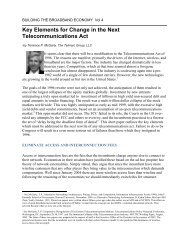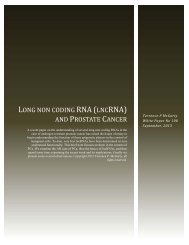progressivism, individualism, and the public ... - Telmarc Group
progressivism, individualism, and the public ... - Telmarc Group
progressivism, individualism, and the public ... - Telmarc Group
Create successful ePaper yourself
Turn your PDF publications into a flip-book with our unique Google optimized e-Paper software.
The <strong>Telmarc</strong> <strong>Group</strong><br />
PROGRESSIVISM, INDIVIDUALISM, AND THE PUBLIC<br />
INTELLECTUAL<br />
7 VISIONS AND VIEWS<br />
We now want to return to <strong>the</strong> question of why some become neo-progressives <strong>and</strong> some<br />
neo-individualists. To do this we do two things. First we look at a somewhat<br />
philosophical structure which concentrates on people <strong>and</strong> <strong>the</strong>ir world views as expressed<br />
I <strong>the</strong> architectures of <strong>the</strong> entities which <strong>the</strong>y design. Then we go back <strong>and</strong> look at<br />
socialism a century ago <strong>and</strong> <strong>the</strong>n look at <strong>the</strong> Obama administration. We <strong>the</strong>n try to ties<br />
<strong>the</strong> philosophical structure <strong>and</strong><br />
7.1 ARCHITECTURES, WORLD VIEWS AND INTERPRETING GOVERNING STRUCTURES<br />
We now will look at a general construct for political systems <strong>and</strong> how <strong>the</strong> various<br />
approaches we have been discussing may fit within <strong>the</strong>m. We do so by introducing<br />
several concepts, principally that of architecture <strong>and</strong> world view.<br />
Let us start with a simple example <strong>and</strong> <strong>the</strong>n we will extend it to <strong>the</strong> political domain.<br />
Here is how it may work. Let us consider a builder of academic buildings, such as would<br />
be done on <strong>the</strong> MIT campus. The powers that be on <strong>the</strong> campus decide <strong>the</strong>y want a new<br />
building to house some group of researchers, say electrical engineering <strong>and</strong> computer<br />
science, a group which has been separate <strong>and</strong> apart since <strong>the</strong> beginnings of computer<br />
science. But we now want <strong>the</strong>m toge<strong>the</strong>r.<br />
They go off to an architect who will design <strong>the</strong> building <strong>and</strong> <strong>the</strong>n have it built. The<br />
building will <strong>the</strong>n create an atmosphere for getting <strong>the</strong>se two groups to work with one<br />
ano<strong>the</strong>r. So off <strong>the</strong> group goes <strong>and</strong> seeks out an architect. For each <strong>and</strong> every architect<br />
<strong>the</strong>re exists some example of how things may be, how buildings should be, as say Frank<br />
Lloyd Wright would design <strong>the</strong>m, <strong>and</strong> we use this example, this paradigm, as <strong>the</strong><br />
foundation for say that school. Let us call this <strong>the</strong> Wrightian school for wont of a better<br />
term. There may be a large group of such architects <strong>and</strong> <strong>the</strong>y all share <strong>the</strong> same view, say<br />
openness <strong>and</strong> large windows <strong>and</strong> whatever. Thus we say <strong>the</strong>y have <strong>the</strong> same world view<br />
of how to design. There may be o<strong>the</strong>r architects with o<strong>the</strong>r world views with o<strong>the</strong>r<br />
paradigms. We may have <strong>the</strong> Classicists who like large marble columns <strong>and</strong> gr<strong>and</strong><br />
openings. We may have <strong>the</strong> avant guard types with sweeping windows. But <strong>the</strong> first two<br />
points are that <strong>the</strong>re are examples or paradigms which in turn inspire world views for<br />
groups.<br />
Now <strong>the</strong> architect must have a roof, walls, windows, <strong>and</strong> o<strong>the</strong>r elements which define a<br />
building. The engineers define <strong>the</strong>se things, it may need a foundation <strong>and</strong> <strong>the</strong> like. The<br />
elements are <strong>the</strong> general parts of a building, <strong>the</strong>y are needed to make it work, <strong>the</strong>y have<br />
been approved in some code. The architect using his world view may move <strong>the</strong>m around,<br />
give each a different emphasis, a broader or lesser focus, but each must be <strong>the</strong>re. Now <strong>the</strong><br />
architect may have a variety of effectors, technologies, materials that he can use for each<br />
Page 187












